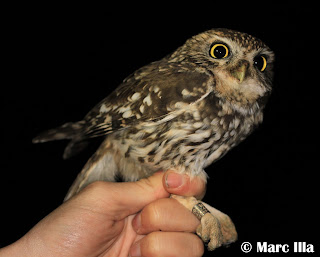January started in a quite exciting way with many good birds being found in the Ebre Delta; and indeed this has been so far a very good rarities year in Catalunya. I could not resist the temptation to go to the Ebre Delta to see the
Sociable Lapwing (Vanellus gregarius) and the
Lesser Yellowlegs (Tringa flavipes)...
After that, the winter kept as it was, with very few or actually no individuals of winter species like
Siskin (Spinus spinus),
Brambling (Fringilla montifringilla) or
Hawfinch (Coccothraustes coccothraustes); three typical irruptive wintering species that can vary quite much in numbers within years. Anyway, it looks like it has been a good winter season for both
Dunnock (Prunella modularis) and
Robin (Erithacus rubecula), and while it was initially quite bad for
Song Thrushes (Turdus philomelos), it has appeared to be quite good during January (all of this based on local observations in central Catalunya!).
 |
I had never tried a Macro (100mm) lens for birds,
quite nice results! |
Indeed, a species that has been clearly quite common through this winter was
Jack Snipe (Lymnocryptes minimus), with several sightings of several individuals together in many places. We've had some wintering individuals for the last few years in
l'Agulla Park, but never so many as this year, since we had 6 wintering individuals.
 |
| Can you see the Jack Snipe? ;) |
Some interesting trapped birds follows.
This
Little Owl (Athene noctua) was actually a recapture from last summer (July 2016), when it was caught as a breeding individual in the same place. It was very interesting to have an 'age-proved' Little Owl in order to improve the moult and ageing knowledge of the species.
 |
| Adult (EURING 6) |
The
Great Spotted Woodpecker (Dendrocopos major) is a very scarce visitor in my local wetland, and indeed it's even more unlikely to have one in the nets, since they usually climb on higher parts of the trees. So it was a great surprise to get this one, a very nice second-year (EURING 5) female; with
all primary coverts and most of greater coverts and alula unmoulted.
Dartford Warblers (Sylvia undata) are rather common in certain areas, but these places are usually very open, with low bushes, and they are usually not easy to catch with nets. So this adult (EURING 6) male was a very appreciated bird during my CES at Montserrat Mountain.
So far it has been a quite good winter for
Reed Buntings (Emberiza schoeniclus), with more than 280 ringed in the area where I've been working the last winters. This year I had three foreign recoveries (1 from Finland and 2 from France), and I already got the information from the French birds; both ringed during last autumn (2016), one of them just 15 days befire I caught it!, and both from SE France. Also, I received the information corresponding to one of my birds (ringed during November 2014) that was caught at Darmsatd (Germany) during October 2016. Quite interesting stuff!
After having examined the postjuvenile moult extension in quite many Reed Buntings, I think I can safely state that this female is the one with the less extensive moult I have ever seen, with the three outermost greater coverts unmoulted! (bad picture with the phone and flash...)
The
Black-headed Gull (Chroicocephalus ridibundus) ringing project in Barcelona city continued this winter, with our record of captures, thanks to a very good day of 15 individuals caught. Check for blue colour-rings!!
 |
| Barcelona's harbour |
Several Black-headed Gulls have appeared with foreing rings this year, like this one from Denmark that was seen in the area already on February 2012, but no more sightings until this year!
 |
| Picture by Raül Aymí |
Also related to Gulls, I could spend some very interesting afternoons in an old factory at
Roda de Ter (Osona) with Martí Franch, and we actually managed to see some interesting Gulls for the area. Among the (roughly) 2000
Yellow-legged Gulls (Larus michahellis) that regularly go to roost there, we found 3
Herring Gulls (Larus argentatus) (a first-winter, a second-winter and an adult) and at least 2
Caspian Gulls (Larus cachinnans), plus to possible hybrids with some
cachinnans part on them. Also, around 15
Lesser Black-backed Gulls (Larus fuscus) were present, but that's a regular species there. All pictures are taken with the phone through the scope...
 |
| First-winter Herring Gull (Larus argentatus) |
 |
| Second-winter Herring Gull (Larus argentatus) |
 |
| Adult Herring Gull (Larus argentatus) |
 |
| First-winter Caspian Gull (Larus cachinnans) |
 |
| Pale first-winter Lesser Black-backed Gull (Larus fuscus) (left) and 1w Yellow-legged (Larus michahellis) (right) |






























